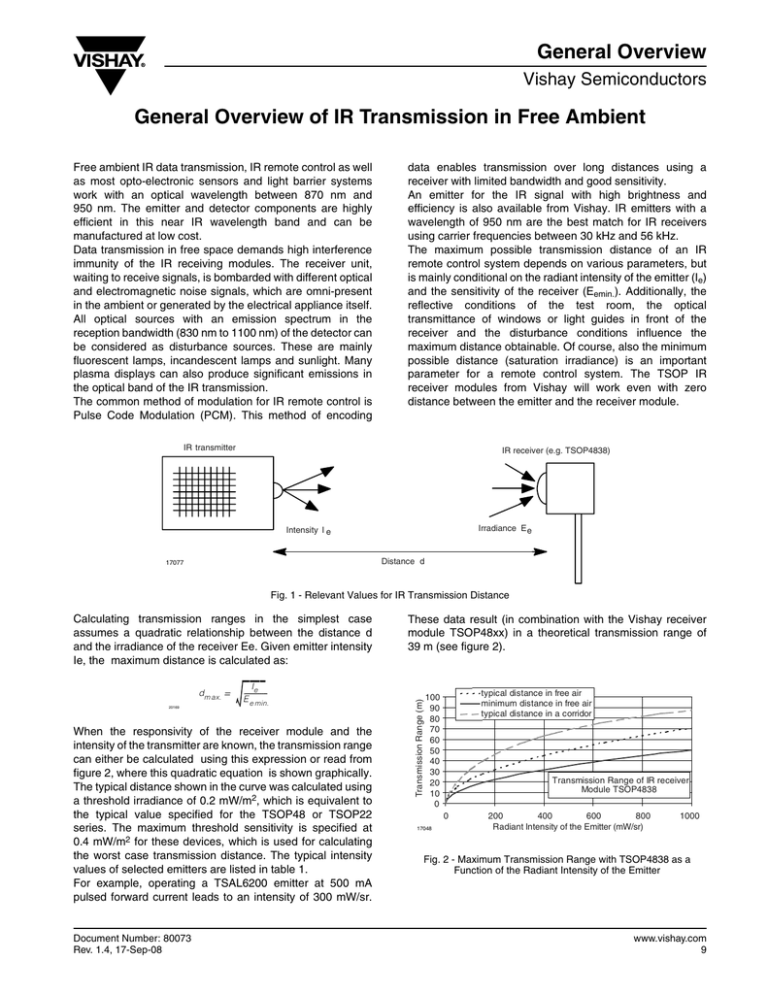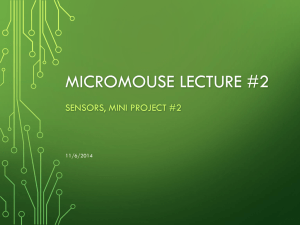General Overview General Overview of IR Transmission in Free Ambient Vishay Semiconductors
advertisement

General Overview Vishay Semiconductors General Overview of IR Transmission in Free Ambient Free ambient IR data transmission, IR remote control as well as most opto-electronic sensors and light barrier systems work with an optical wavelength between 870 nm and 950 nm. The emitter and detector components are highly efficient in this near IR wavelength band and can be manufactured at low cost. Data transmission in free space demands high interference immunity of the IR receiving modules. The receiver unit, waiting to receive signals, is bombarded with different optical and electromagnetic noise signals, which are omni-present in the ambient or generated by the electrical appliance itself. All optical sources with an emission spectrum in the reception bandwidth (830 nm to 1100 nm) of the detector can be considered as disturbance sources. These are mainly fluorescent lamps, incandescent lamps and sunlight. Many plasma displays can also produce significant emissions in the optical band of the IR transmission. The common method of modulation for IR remote control is Pulse Code Modulation (PCM). This method of encoding data enables transmission over long distances using a receiver with limited bandwidth and good sensitivity. An emitter for the IR signal with high brightness and efficiency is also available from Vishay. IR emitters with a wavelength of 950 nm are the best match for IR receivers using carrier frequencies between 30 kHz and 56 kHz. The maximum possible transmission distance of an IR remote control system depends on various parameters, but is mainly conditional on the radiant intensity of the emitter (Ie) and the sensitivity of the receiver (Eemin.). Additionally, the reflective conditions of the test room, the optical transmittance of windows or light guides in front of the receiver and the disturbance conditions influence the maximum distance obtainable. Of course, also the minimum possible distance (saturation irradiance) is an important parameter for a remote control system. The TSOP IR receiver modules from Vishay will work even with zero distance between the emitter and the receiver module. IR transmitter IR receiver (e.g. TSOP4838) Irradiance E e Intensity I e Distance d 17077 Fig. 1 - Relevant Values for IR Transmission Distance dm ax. = 20169 Ie -----------E e min. When the responsivity of the receiver module and the intensity of the transmitter are known, the transmission range can either be calculated using this expression or read from figure 2, where this quadratic equation is shown graphically. The typical distance shown in the curve was calculated using a threshold irradiance of 0.2 mW/m2, which is equivalent to the typical value specified for the TSOP48 or TSOP22 series. The maximum threshold sensitivity is specified at 0.4 mW/m2 for these devices, which is used for calculating the worst case transmission distance. The typical intensity values of selected emitters are listed in table 1. For example, operating a TSAL6200 emitter at 500 mA pulsed forward current leads to an intensity of 300 mW/sr. Document Number: 80073 Rev. 1.4, 17-Sep-08 These data result (in combination with the Vishay receiver module TSOP48xx) in a theoretical transmission range of 39 m (see figure 2). Transmission Range (m) Calculating transmission ranges in the simplest case assumes a quadratic relationship between the distance d and the irradiance of the receiver Ee. Given emitter intensity Ie, the maximum distance is calculated as: typical distance in free air minimum distance in free air typical distance in a corridor 100 90 80 70 60 50 40 30 20 10 0 Transmission Range of IR receiver Module TSOP4838 0 17048 200 400 600 800 Radiant Intensity of the Emitter (mW/sr) 1000 Fig. 2 - Maximum Transmission Range with TSOP4838 as a Function of the Radiant Intensity of the Emitter www.vishay.com 9 General Overview Vishay Semiconductors General Overview of IR Transmission in Free Ambient In practice, the relationship between irradiance and transmission distance does not exactly follow a quadratic curve. In most cases, the actual distance is longer than calculated by the expression. This means that the example calculated here can be used as a worst case in free air and in reality better transmission ranges are attained. However, whenever an opaque window or light pipe is used between the receiver and the emitter, the actual transmission distance will be reduced. Comparisons of remote control systems are often performed in long corridors. As indicated in figure 2, the transmission range is increased above the typical distance under these test conditions because of the reflective properties of the walls, the ceilings and other objects. Thus in a corridor, the function of the irradiance vs. distance does not obey a quadratic expression. The required levels for transmission optical power in an enclosed room can be estimated by using other approximations. If we assume that the whole inner surface of a room (e.g. floor area of 30 m2, height of 2.5 m) is irradiated with the emission of an infrared source with an overall irradiance of Ee = 0.4 mW/m2, then an emitted radiant flux of 50 mW is necessary (surface = 115 m2, 100 % efficiency). With an 80 % reflection loss, about 250 mW of emitted radiation will be required for reliable reception in the whole room. 250 mW is a value, which can be achieved with an emitter TSAL6400 operating at a peak forward current of 700 mA. Under these conditions, no direct path between the emitter and the receiver is assumed, but that radiation will reach the detector after at least one reflection. This kind of remote control system is very user friendly for the customer because he can aim the handset in any direction of his living room. An IR emitter with a wide emitting angle will also provide this kind of comfortable remote control system. TABLE 1 - EMITTERS FOR TSOP RECEIVER MODULES EMITTER PACKAGE WAVELENGTH DIAMETER nm RADIANT FLUX IF = 100 mA mw typ. RADIANT INTENSITY IF = 100 mA EMISSION mW/sr ANGLE typ. REMARKS TSAL4400 3 mm 950 35 30 ± 25° blue resin TSAL5100 5 mm 950 35 130 ± 10° Leads with stand off, blue resin TSAL6100 5 mm 950 35 130 ± 10° blue resin TSAL6200 5 mm 950 35 60 ± 17° blue resin TSAL7200 5 mm 950 35 60 ± 17° clear resin TSAL5300 5 mm 950 35 45 ± 22° Leads with stand off, blue resin TSAL7300 5 mm 950 35 45 ± 22° clear resin TSAL6400 5 mm 950 35 40 ± 25° blue resin TSAL7400 5 mm 950 35 40 ± 25° clear resin TSAL7600 5 mm 950 35 35 ± 30° clear resin TSML1020 SMD 950 35 35 ± 12° Clear SMD package with lens TSML3700 SMD 950 35 7 ± 60° PL-CC-2 SMD package All IR emitting diodes shown in table 1 are suitable for use with the Vishay IR receivers for standard remote control applications (30 kHz to 56 kHz). The rise time and fall time of these IR emitters is about 800 ns. www.vishay.com 10 Document Number: 80073 Rev. 1.4, 17-Sep-08





